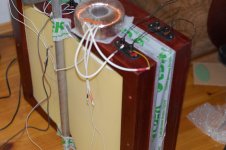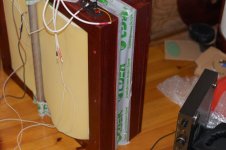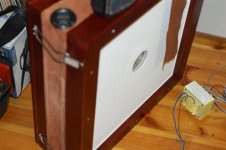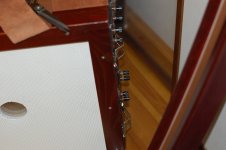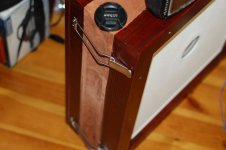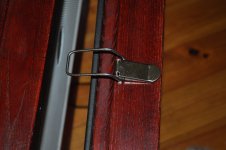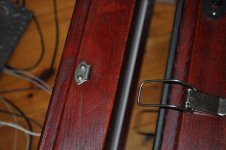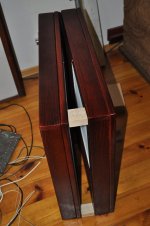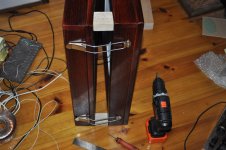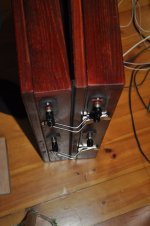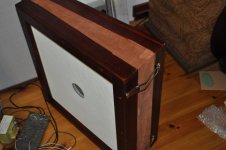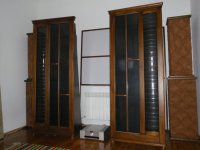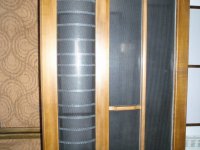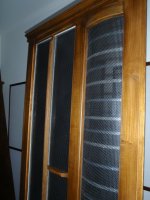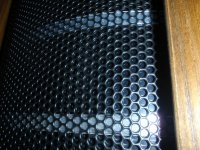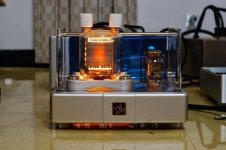Hello friends. For a long time already, about 5 years I had unfinished acoustic systems, but recently I decided to finish them all the same. The speakers consist of a bass segment, which in turn is built of a double membrane stack, each with 4 stators and 3 membranes, a total of 6 membranes and 8 stators composed by isobaric. As well as a high-frequency emitter. Everything that I do I will gradually spread here.
Attachments
That sounds like quite a project! Not sure I understand the complete setup, but will follow with interest!
Jan
Jan
Collected the second subwoofer. The whole system was working, only it was necessary to assemble it cleanly, but I finished with the subwoers. A few words about them. As I wrote earlier, each subwoofer consists of two identical parts, if you just squeeze them together, you get several parasitic resonances, so I had to get away from parallel connection. The hole that turned out at the same time was sealed with natural leather, since the material should be pliable, and not tough and elastic. But one resonance remains, it is in the region of 500 Hz, I remove it with an equalizer, because it was not possible to remove it using the acoustic method. For subwoofers I use step-up toroidal transformers with a power of 350 watts, a transformation ratio of 1-200. The working range is 25Hz-1000Hz, then there is a smooth decline.
Attachments
Further. The bass segment stators are made of 3mm metal. thick for increased rigidity. The working size of the bass panel is 500 / 500mm. The high-frequency strip is made with a height of 1900mm. and a width of 20mm. Here I must step back a little and tell you why I came to such a construction of a high-frequency emitter. Once visiting this forum, I posted a photo of my ESL where horizontally bent panels a la Martin Logan appeared and I was criticized by several people for this that allegedly these panels emit an incorrect high-frequency signal and at the same time the temporal characteristics are violated, that is, an interference porridge is obtained. I thought a lot))), asked about the size of the emitter and the long waveform, as well as the stereo format. As a result, I came to the conclusion that in the horizontal area the high-frequency emitter should not exceed 20mm in physical dimensions. In this case, we will have a wide-beam signal up to 16000 Hz, since the wavelength is 20mm. will correspond to 16000Hz. In the photo I am laying out a rough version of the articulation of two strips, then I will make a special mount with the ability to adjust the high-frequency emitter in the vertical plane, but for now everything is kept on scotch tape))). Further. The high-frequency radiator is bent in the vertical plane in order to collect the signal from the entire length of the radiator (1900 mm) into one point at the listener's ear. The bending radius in the vertical plane is 3000mm, this is the distance I have from the speakers to the sofa with my beloved))) As a result, the sound is very accurate and the sensitivity is approximately doubled. The high-frequency emitter stators are made of a woven mesh material of bronze and high acoustic transparency. The working range of these emitters is 600Hz-ultrasound.
Attachments
-
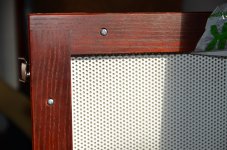 DSC_9456.JPG375.3 KB · Views: 492
DSC_9456.JPG375.3 KB · Views: 492 -
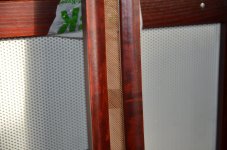 DSC_9454.JPG343.3 KB · Views: 426
DSC_9454.JPG343.3 KB · Views: 426 -
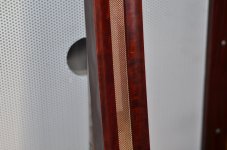 DSC_9435.JPG264.7 KB · Views: 419
DSC_9435.JPG264.7 KB · Views: 419 -
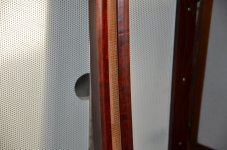 DSC_9452.JPG378.1 KB · Views: 405
DSC_9452.JPG378.1 KB · Views: 405 -
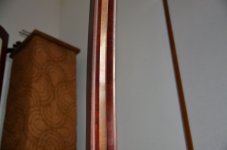 DSC_9464.JPG155.9 KB · Views: 393
DSC_9464.JPG155.9 KB · Views: 393 -
 DSC_9448.JPG177 KB · Views: 390
DSC_9448.JPG177 KB · Views: 390 -
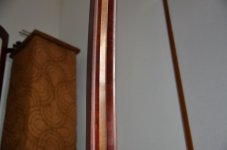 DSC_9464.JPG155.9 KB · Views: 423
DSC_9464.JPG155.9 KB · Views: 423 -
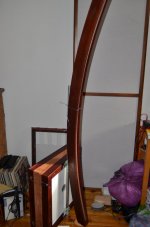 DSC_9474.JPG239.7 KB · Views: 416
DSC_9474.JPG239.7 KB · Views: 416 -
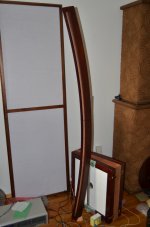 DSC_9482.JPG264 KB · Views: 505
DSC_9482.JPG264 KB · Views: 505 -
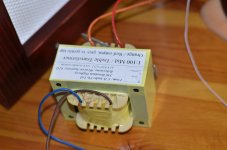 DSC_9437.JPG187.1 KB · Views: 516
DSC_9437.JPG187.1 KB · Views: 516 -
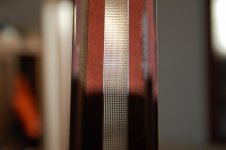 DSC_0031.JPG261.8 KB · Views: 521
DSC_0031.JPG261.8 KB · Views: 521
Fine woodwork and craftsmanship there for sure - congratulations!
How does the sound come out for you? Do you happen to have some measurements - it would be interesting to see.
//
How does the sound come out for you? Do you happen to have some measurements - it would be interesting to see.
//
Thank you!Fine woodwork and craftsmanship there for sure - congratulations!
How does the sound come out for you? Do you happen to have some measurements - it would be interesting to see.
//
Measurements will come in time, or rather I did it five years ago, when I first started doing this ESL.
To date, I have only corrected a few things.
Subjectively the sound is completely satisfied with me.
It's not my first ESL, in time I got over the gigantism of construction))) and moved to a more compact, but more efficient options, as it seems to me.
The sound of these speakers doesn't remind standard ELFs with large radiating area, and moreover with conical speaker at the bottom of the range.
The bass, due to the fact that 6 membranes work in parallel, is very solid and dynamic.
And the fact that the planar transducers are very well matched in phase, you also know.
Hi,
Very interesting project. I have been planning to build such an esl for a long time. What does it sound like?
I apologize for my poor English🙂
Best wishes,
Robert
Very interesting project. I have been planning to build such an esl for a long time. What does it sound like?
I apologize for my poor English🙂
Best wishes,
Robert
Hi.
It doesn't look like anything, I personally have not seen prototypes like mine anywhere.Maybe I didn't look hard enough))).
It doesn't look like anything, I personally have not seen prototypes like mine anywhere.Maybe I didn't look hard enough))).
I went to the link, but did not see anything there, if you can, then explain what is there.I found a reference in the The Electrostatic Loudspeaker Design Cookbook by Roger R. Sanders.
I would like to remind you that this ESL I posted back in 2015 or 2016 on several forums on the hi-fi.
If you need, I can find and give links to them.
In the meantime, I recorded a track with George Benson on microphones and a Tаskam recorder.
Recorded it from the listening position:https://drive.google.com/file/d/1MbgZOMY9-4GMiJbYzeG0yxikLjNd6ZTW/view?usp=sharing
This video I posted 4 years ago, before that there were also videos with this subwoofer, but only one, the second was not ready, but the high-frequency satellites were ready at that time and you can see them in the dark (at that time I did not want to show this ESL completely).v=gyfRLzZdTUU
Last edited:
I found a reference in the The Electrostatic Loudspeaker Design Cookbook by Roger R. Sanders.
You must have misunderstood me, I was referring to electrostatic emitters of exactly the same design as I posted here, not electrostatics in general.
They were actually invented in the 19th century of the last millennium, but there was no suitable material until mylar was invented in 1948.
And the first experiments with electrostatics were carried out with well-treated pig stomachs.It was not the right thing, cinemas could not be sounded, because there were no powerful transistor amplifiers))).
I'm sorry I didn't send a link, only the title of the book. Your ESL has an amazing voice. What grabbed me was the dynamics. So far, I’ve only heard flat anemic-sounding ESL. Unfortunately the people don’t understand that need other types of amplifiers to power these speakers.
But my amplifier doesn't really bring out these speakers, either.I'm sorry I didn't send a link, only the title of the book. Your ESL has an amazing voice. What grabbed me was the dynamics. So far, I’ve only heard flat anemic-sounding ESL. Unfortunately the people don’t understand that need other types of amplifiers to power these speakers.
Ideally I need a direct drive voltage amplifier (many volts)),without step-up transformers.
I know a guy who can do it, but it may take some time, because I need two amplifiers, one for the bass register and one for the treble.
He made an amplifier for electrostatic headphones for me, but still can not send it, finalizing it for about one year, all he does not like something in the sound))).
This sounds excellent. Congratulations. Can you post some more clips please?video I posted 4 years ago
The spectrum of the plucked double bass intro in your youtube clip shows very clean peaks. Looks like your ESL bass panel design does great impulse. Gives that dynamic live sound:
Dynamic range analysis = 15 !ESL has an amazing voice. What grabbed me was the dynamics.
In this video on YouTube I had only one subwoofer at the time, but through two step-up transformers I summed up the sound from the two channels of the amplifier into one subwoofer.This sounds excellent. Congratulations. Can you post some more clips please?
The spectrum of the plucked double bass intro in your youtube clip shows very clean peaks. Looks like your ESL bass panel design does great impulse. Gives that dynamic live sound:
View attachment 1009939
Dynamic range analysis = 15 !
View attachment 1009940
This is also a very interesting topic in electrostatics)))).
Now I am building a 300 b amplifier it would be interesting to test the ESL without step-up transformers. If I finished my system building, I will start to build this ESL. It's a fantastic project and congratulations to it.
It is unlikely that 300V will be enough voltage at the anode to swing the ESL.Now I am building a 300 b amplifier it would be interesting to test the ESL without step-up transformers. If I finished my system building, I will start to build this ESL. It's a fantastic project and congratulations to it.
But the Soviet tube GU-48 is able to do it, it has 3000 volts at the anode output.
Several amplifiers are made on this tube, only one power unit weighs 40kg))).
Here is this tube in all its beauty:
Attachments
- Home
- Loudspeakers
- Planars & Exotics
- Full-range, two-way ESL
